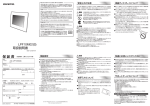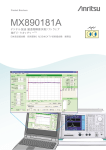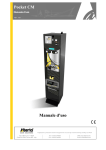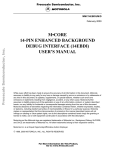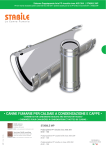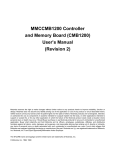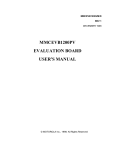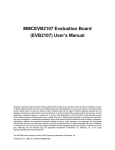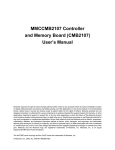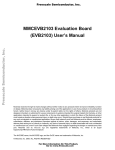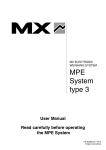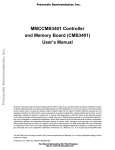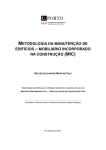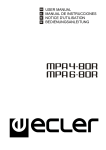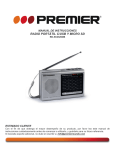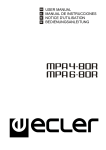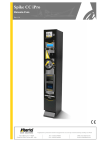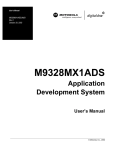Download User`s Manual - Abcelectronique
Transcript
Freescale Semiconductor, Inc. Freescale Semiconductor, Inc... EVB2080 Evaluation Board (EVB2080) User’s Manual Motorola reserves the right to make changes without further notice to any products herein to improve reliability, function or design. Motorola does not assume any liability arising out of the application or use of any product or circuit described herein; neither does it convey any license under its patent rights nor the rights of others. Motorola products are not designed, intended, or authorized for use as components in systems intended for surgical implant into the body, or other applications intended to support or sustain life, or for any other application in which the failure of the Motorola product could create a situation where personal injury or death may occur. Should Buyer purchase or use Motorola products for any such unintended or unauthorized application, Buyer shall indemnify and hold Motorola and its officers, employees, subsidiaries, affiliates, and distributors harmless against all claims, costs, damages, and expenses, and reasonable attorney fees arising out of, directly or indirectly, any claim of personal injury or death associated with such unintended or unauthorized use, even if such claim alleges that Motorola was negligent regarding the design or manufacture of the part. Motorola and B are registered trademarks of Motorola, Inc. Motorola, Inc. is an Equal Opportunity/Affirmative The M•CORE name and logotype and the OnCE name are trademarks of Motorola, Inc. © Motorola, Inc. 1999 For More Information On This Product, Go to: www.freescale.com Freescale Semiconductor, Inc. CAUTION: ESD Protection Freescale Semiconductor, Inc... M•CORE development systems include open-construction printed circuit boards that contain static-sensitive components. These boards are subject to damage from electrostatic discharge (ESD). To prevent such damage, you must use static-safe work surfaces and grounding straps, as defined in ANSI/EOS/ESD S6.1 and ANSI/EOS/ESD S4.1. All handling of these boards must be in accordance with ANSI/EAI 625. MOTOROLA 2 MMCEVB2080UM/D User’s Manual For More Information On This Product, Go to: www.freescale.com Freescale Semiconductor, Inc. Contents Section 1 Introduction Freescale Semiconductor, Inc... 1.1 1.2 1.3 EVB2080 Features . . . . . . . . . . . . . . . . . . . . . . . . . . . . . . . . . . . . . . . . . . . . . . 9 System and User Requirements . . . . . . . . . . . . . . . . . . . . . . . . . . . . . . . . . . . 10 EVB2080 Layout . . . . . . . . . . . . . . . . . . . . . . . . . . . . . . . . . . . . . . . . . . . . . . 10 Section 2 Configuration 2.1 Configuring Board Components . . . . . . . . . . . . . . . . . . . . . . . . . . . . . . . . . . . 13 2.1.1 Setting the FLASH Data Bus Access Header (W1). . . . . . . . . . . . . . . . . . 16 2.1.2 Setting the Chip Select Headers (W2, W4) . . . . . . . . . . . . . . . . . . . . . . . . 17 2.1.3 Setting the SRAM Data Bus Access Header (W3) . . . . . . . . . . . . . . . . . . 18 2.1.4 Using Processor Power Connect Headers (W5 — W8). . . . . . . . . . . . . . . 18 2.1.5 Setting the Software Select Switch (S2) . . . . . . . . . . . . . . . . . . . . . . . . . . 20 2.1.6 Setting the Memory Byte State Switch (S3) . . . . . . . . . . . . . . . . . . . . . . . 21 2.2 Making Computer System Connections . . . . . . . . . . . . . . . . . . . . . . . . . . . . . 22 2.3 Performing the EVB2080 Selftest . . . . . . . . . . . . . . . . . . . . . . . . . . . . . . . . . 22 2.4 Memory Map . . . . . . . . . . . . . . . . . . . . . . . . . . . . . . . . . . . . . . . . . . . . . . . . . 24 2.5 Using the Prototyping Area . . . . . . . . . . . . . . . . . . . . . . . . . . . . . . . . . . . . . . 25 Section 3 Operation 3.1 Debugging Embedded Code . . . . . . . . . . . . . . . . . . . . . . . . . . . . . . . . . . . . . . 27 3.1.1 Using the Picobug Monitor . . . . . . . . . . . . . . . . . . . . . . . . . . . . . . . . . . . . 27 3.1.2 Picobug Sample Session . . . . . . . . . . . . . . . . . . . . . . . . . . . . . . . . . . . . . . 29 3.1.3 Using the GNU Source-Level Debugger . . . . . . . . . . . . . . . . . . . . . . . . . . 32 3.2 Downloading to FLASH Memory . . . . . . . . . . . . . . . . . . . . . . . . . . . . . . . . . 32 3.2.1 Using the SysDS Loader . . . . . . . . . . . . . . . . . . . . . . . . . . . . . . . . . . . . . . 32 3.2.2 Restoring System Software . . . . . . . . . . . . . . . . . . . . . . . . . . . . . . . . . . . . 37 3.3 MPB I/O Port Circuits . . . . . . . . . . . . . . . . . . . . . . . . . . . . . . . . . . . . . . . . . . 38 3.4 Accommodating Processor Differences . . . . . . . . . . . . . . . . . . . . . . . . . . . . . 39 MMCEVB2080UM/D User’s Manual For More Information On This Product, Go to: www.freescale.com 3 Freescale Semiconductor, Inc. Section 4 Connector Information OnCE Connector (J27) . . . . . . . . . . . . . . . . . . . . . . . . . . . . . . . . . . . . . . . . . . 41 RS232 Connector (J26). . . . . . . . . . . . . . . . . . . . . . . . . . . . . . . . . . . . . . . . . . 42 Prototyping Connector Sites (J14, J16) . . . . . . . . . . . . . . . . . . . . . . . . . . . . . 43 Freescale Semiconductor, Inc... 4.1 4.2 4.3 4 MMCEVB2080UM/D User’s Manual For More Information On This Product, Go to: www.freescale.com Freescale Semiconductor, Inc. Freescale Semiconductor, Inc... Figures 1-1 3-1 3-2 3-3 4-1 4-2 4-3 MMCEVB2080 Evaluation Board . . . . . . . . . . . . . . . . . . . . . . . . . . . . . . . . . 11 SysDS Loader Main Screen . . . . . . . . . . . . . . . . . . . . . . . . . . . . . . . . . . . . . . 33 Upload To File Dialog Box . . . . . . . . . . . . . . . . . . . . . . . . . . . . . . . . . . . . . . 34 Display Flash/Ram Display . . . . . . . . . . . . . . . . . . . . . . . . . . . . . . . . . . . . . . 35 OnCE Connector J27 Pin Assignments . . . . . . . . . . . . . . . . . . . . . . . . . . . . . 41 Connector Location J14 Pin Assignments . . . . . . . . . . . . . . . . . . . . . . . . . . . 43 Connector Location J16 Pin Assignments . . . . . . . . . . . . . . . . . . . . . . . . . . . 45 MMCEVB2080UM/D User’s Manual For More Information On This Product, Go to: www.freescale.com 5 Freescale Semiconductor, Inc... Freescale Semiconductor, Inc. 6 MMCEVB2080UM/D User’s Manual For More Information On This Product, Go to: www.freescale.com Freescale Semiconductor, Inc. Freescale Semiconductor, Inc... Tables 1-1 2-1 2-2 2-3 2-4 2-5 3-1 3-2 3-3 4-1 4-2 4-3 4-4 MMCEVB2080 Evaluation Board Specifications . . . . . . . . . . . . . . . . . . . . . 12 Component Configuration Settings . . . . . . . . . . . . . . . . . . . . . . . . . . . . . . . . 13 S2 Subswitch Settings. . . . . . . . . . . . . . . . . . . . . . . . . . . . . . . . . . . . . . . . . . . 20 Reset Vector Source . . . . . . . . . . . . . . . . . . . . . . . . . . . . . . . . . . . . . . . . . . . . 21 EVB2080 Self-Test LED Sequence . . . . . . . . . . . . . . . . . . . . . . . . . . . . . . . . 23 EVB2080 Default Memory Map . . . . . . . . . . . . . . . . . . . . . . . . . . . . . . . . . . 24 Picobug Commands . . . . . . . . . . . . . . . . . . . . . . . . . . . . . . . . . . . . . . . . . . . . 28 Memory Range/Sector Contents . . . . . . . . . . . . . . . . . . . . . . . . . . . . . . . . . . . 37 MPB, MPA Connections . . . . . . . . . . . . . . . . . . . . . . . . . . . . . . . . . . . . . . . . 39 OnCE Connector J27 Signal Descriptions . . . . . . . . . . . . . . . . . . . . . . . . . . . 41 RS232 Connector J26 Pin Assignments . . . . . . . . . . . . . . . . . . . . . . . . . . . . . 42 Connector Location J14 Signal Descriptions . . . . . . . . . . . . . . . . . . . . . . . . . 43 Connector Location J16 Signal Descriptions . . . . . . . . . . . . . . . . . . . . . . . . . 45 MMCEVB2080UM/D User’s Manual For More Information On This Product, Go to: www.freescale.com 7 Freescale Semiconductor, Inc... Freescale Semiconductor, Inc. 8 MMCEVB2080UM/D User’s Manual For More Information On This Product, Go to: www.freescale.com Freescale Semiconductor, Inc. EVB2080 Features Section 1 Introduction Freescale Semiconductor, Inc... This user’s manual explains connection, configuration, and operation information for the MMCEVB2080 Evaluation Board (EVB2080), a development tool of Motorola’s M•CORE™ family. The EVB2080 lets you develop code to be embedded in either an MMC2080 or MMC2075 microcontroller unit. A standalone tool, the EVB2080 uses an RS232 connection to your computer. This connection lets you use Motorola’s M•CORE System Development Software (SysDS) or the GNU source-level debugger. The SysDS consists of a loader, the Picobug monitor, the ESL monitor, and the built-in selftest. The EVB2080 also has a OnCE™ connector, enabling you to use a debugging application that requires one. Optionally, you may use the EVB2080 with a different emulator product, such as the Motorola Embedded Background Debug Interface (EBDI). Motorola's SysDS loader lets you download your code into the EVB2080's SRAM (for execution) or FLASH memory (for execution or for storage in non-volatile memory). Should your application overwrite factory programming in the FLASH memory device, you can use the SysDS loader to restore the factory programming. 1.1 EVB2080 Features The EVB2080 features: • MMC2080 resident MCU (a development version, in a 208-pin PQFP package). • 1 megabyte FLASH memory. • 512 kilobytes 70-nanosecond SRAM. • Power supply that converts line power to 12-volt input power. • An RS232 serial communication port. • Designed for a 16-bit data bus, but can be configured for 8-bit bus operation. • OnCE connector. • 4 user-accessible LEDs. • 4 general-purpose DIP switches (2 shared with power-up software selection). • User prototyping (breadboard) area. • Provision for user installation of optional prototyping connectors. • Motorola's System Development Software (SysDS). • GNU source-level debugger (from the Free Software Foundation). MMCEVB2080UM/D User’s Manual For More Information On This Product, Go to: www.freescale.com 9 Freescale Semiconductor, Inc. Introduction 1.2 System and User Requirements You need an IBM PC or compatible computer, running the Windows 95 or WindowsNT (version 4.0) operating system. The computer requires a Pentium (or equivalent) microprocessor, 16 megabytes of RAM, 50 megabytes of free hard-disk space, an SVGA color monitor, and an RS232 serial-communications port. To use the Picobug debug monitor, you also need Hyperterminal or a comparable terminal-emulation program. Freescale Semiconductor, Inc... To get the most from your EVB2080, you should be an experienced C or M•CORE assembly programmer. Your EVB2080 requires 12-volt input power, at 0.5 amperes. The power supply that comes with your EVB2080 provides this voltage from line power. 1.3 EVB2080 Layout Figure 1-1 shows the layout of the EVB2080. Jumper header W1 specifies 8-bit or 16-bit FLASH data-bus access. Jumper header W2 specifies the FLASH chip select. Jumper header W3 specifies 8-bit or 16-bit SRAM addressing. Jumper header W4 specifies the SRAM chip select. Jumper headers W5 through W8 are power-interrupt headers, available for current measurement. Connector J19 is the connector for 12-volt input power. Connector J26 is the RS232 serial connector. Connector J27 is the OnCE connector. Note the unpopulated locations for optional, user-supplied connectors: J14 and J16, for connection to M2080 general-purpose I/O and other system signals; and J15, for a jumper header that grounds the processor pullup-enable signal. Switch S1 is the reset switch. Switch S2 is the general-purpose configuration switch, which specifies the software module to be run upon reset. Switch S3 configures several aspects of memory operation, including 16- or 8-bit operation. Switch S4 simulates a low-battery condition at reset. Switch S5 is the power switch. Location F1 is for the EVB2080 fuse. LEDs DS1 through DS4 (also designated STAT3 through STAT0, respectively) are general-purpose status indicators. LED DS5 confirms 3.3-volt power (and therefore that all parts of the board are powered). The EVB2080 prototyping area is between switch S4 and jumper header W8. The resident MCU, at location U12, is a PMC2080PW001 device, which simulates an MMC2080 device. 10 MMCEVB2080UM/D User’s Manual For More Information On This Product, Go to: www.freescale.com Freescale Semiconductor, Inc. EVB2080 Layout DS1 -- DS4 (STAT3 -- STAT0) S1 W2 W1 S2 W3 S3 W4 DS5 Freescale Semiconductor, Inc... J14 S4 W5 J10 W6 U12 W7 J15 J16 W8 J27 F1 J26 J19 S5 Figure 1-1 MMCEVB2080 Evaluation Board MMCEVB2080UM/D User’s Manual For More Information On This Product, Go to: www.freescale.com 11 Freescale Semiconductor, Inc. Introduction Table 1-1 lists EVB2080 specifications. Table 1-1 MMCEVB2080 Evaluation Board Specifications Characteristic Freescale Semiconductor, Inc... MCU extension I/O port 12 Specifications HCMOS compatible Operating temperature 0° to 40° C Storage temperature -40° to +85° C Relative humidity 0 to 90% (non-condensing) Internal clock 20 megahertz, set by system software, via the PLL function of the resident MCU. External clock 10 megahertz, set by system software, via the PLL function of the resident MCU. On-board crystal 160 kilohertz Power requirements 12 volts dc, at 0.5 amperes, provided from a separate power source Dimensions 6.9 x 8.2 inches (175 x 208 mm) MMCEVB2080UM/D User’s Manual For More Information On This Product, Go to: www.freescale.com Freescale Semiconductor, Inc. Configuring Board Components Section 2 Configuration This section explains how to configure your EVB2080, and how to hook it up to your computer system. 2.1 Configuring Board Components Freescale Semiconductor, Inc... Table 2-1 is a summary of configuration settings; subsections 2.1.1 through 2.1.6 give additional information. Table 2-1 Component Configuration Settings Component Position Effect FLASH Data-Bus Access Jumper Header, W1 Configures 16-bit accesses. Mandatory for using SysDS. 3 1 (Subswitches S3-3 and S3-4 also must be set for 16-bit mode. Header W3 can configure either 16-bit or 8-bit mode for SRAM.) Factory setting. Configures 8-bit accesses. 3 FLASH Chip Select Header, W2, or 1 Configures chip select 0. 1 2 SRAM Chip Select Header, W4 (Each header should have just one jumper.) (Subswitches S3-3 and S3-4 also must be set for 8-bit mode. Header W3 must configure 8-bit mode for SRAM.) Factory setting for header W2. (Required W2 configuration for SysDS.) 7 8 Configures chip select 1. 1 2 Factory setting for header W4. (Required W4 configuration for SysDS.) 7 8 MMCEVB2080UM/D User’s Manual For More Information On This Product, Go to: www.freescale.com 13 Freescale Semiconductor, Inc. Configuration Table 2-1 Component Configuration Settings Component Position FLASH Chip Select Header, W2, or Effect Configures chip select 2. 1 2 7 8 SRAM Chip Select Header, W4 (continued) Freescale Semiconductor, Inc... Configures chip select 3. 1 2 7 8 SRAM Data-Bus Access Jumper Header, W3 Configures 16-bit accesses. Mandatory for using SysDS. 1 3 (Allowed only if header W1 configures 16-bit mode for FLASH.) Factory setting. Configures 8-bit accesses. 1 3 Processor Power Connect Headers, W5 — W8 1 (Mandatory if header W1 configures 8-bit mode for FLASH.) Applies power to processor modules: W5 — oscillator, W6 — PLL, W7 — core; W8 — I/O. Factory setting. 2 Measures power to the processor module. 1 2 Reset Switch, S1 14 Push to reset all board components. MMCEVB2080UM/D User’s Manual For More Information On This Product, Go to: www.freescale.com Freescale Semiconductor, Inc. Configuring Board Components Table 2-1 Component Configuration Settings Component Position Software Select Switch, S2 Effect Runs user code starting at address 0x0102_0000. 5 8 ON 1 4 Runs Picobug monitor for software development. 5 8 Freescale Semiconductor, Inc... ON 1 Factory setting. 4 Runs ESL monitor for software development. 8 5 ON 1 8 4 Runs built-in self-test, which can detect board-level system problems. 5 ON 1 Memory Byte State Switch, S3 4 5 8 ON 1 8 4 Factory setting. 5 ON 1 8 Low Battery Switch, S4 Specifies external boot source, reset vector from the external peripheral CS0 specifies, and 8-bit memory bus access. (Another of 3 plausible configurations.) 4 5 ON 1 Specifies external boot source, reset vector from the external peripheral CS0 specifies, and 16-bit FLASH bus accesses. (One of 3 plausible configurations.) Specifies reset vector from internal ROM and 16-bit memory bus access. (Last of 3 plausible configurations.) 4 Push to simulate a low-battery condition. (This pulls high the processor LOBAT pin.) MMCEVB2080UM/D User’s Manual For More Information On This Product, Go to: www.freescale.com 15 Freescale Semiconductor, Inc. Configuration Table 2-1 Component Configuration Settings Component Position Effect Power Switch, S5 Turns ON EVB2080 power (+5 volts and +3.3 volts). ON OFF Turns OFF EVB2080 power (+5 volts and +3.3 volts — 12-volt power remains present). ON OFF Freescale Semiconductor, Inc... Factory setting. 2.1.1 Setting the FLASH Data Bus Access Header (W1) Jumper header W1 specifies the width of FLASH data-bus accesses. The diagram below shows the factory configuration: the jumper between pins 1 and 2 specifies 16-bit accesses. (This W1 configuration connects the most significant bit of the 16-bit bus to FLASH memory.) NOTES: You must use 16-bit mode in order to use Motorola System Development Software (SysDS). If header W1 configures 16-bit mode, S3 subswitches 3 and 4 also must be set for 16-bit operation. Header W3 can configure either 16-bit mode or 8-bit mode for SRAM accesses. W1 8BIT 3 16BIT (FLASH) 1 Alternatively, you may specify 8-bit data-bus accesses by repositioning the W1 jumper between pins 2 and 3. (This W1 configuration connects the processor address bit 0 to FLASH data bit 15.) NOTE: If header W1 configures 8-bit mode, S3 subswitches 3 and 4 also must be set for 8-bit operation. Header W3 must configure 8-bit mode for SRAM accesses. Although less efficient than 16-bit mode, 8-bit mode is appropriate for some situations. For example, it makes additional general-purpose I/O lines available to your application. But 8-bit mode prevents access to half the EVB2080 RAM, and prevents you from using SysDS. Furthermore, you must configure processor internal registers correctly. (For details, see the processor user’s guide.) 16 MMCEVB2080UM/D User’s Manual For More Information On This Product, Go to: www.freescale.com Freescale Semiconductor, Inc. Configuring Board Components 2.1.2 Setting the Chip Select Headers (W2, W4) Jumper header W2 specifies the FLASH chip select; jumper header W4 specifies the SRAM chip select. The diagram below shows the factory configuration. The jumper between W2 pins 1 and 2 specifies chip select 0 for FLASH memory. The jumper between W4 pins 3 and 4 specifies chip select 1 for SRAM. Freescale Semiconductor, Inc... NOTE: You must use the factory settings of the diagram in order to use Motorola System Development Software (SysDS). W2 FLASH CS 1 2 CS0_b CS1_b CS2_b CS3_b 8 7 W4 SRAM CS 1 2 CS0_b CS1_b CS2_b CS3_b 7 8 Alternatively, you can select chip select 1, 2, or 3 for FLASH memory by repositioning the W2 jumper, respectively, to pins 3 and 4, 5 and 6, or 7 and 8. Similarly, you can select chip select 0, 2, or 3 for SRAM by repositioning the W4 jumper, respectively, to pins 1 and 2, 5 and 6, or 7 and 8. NOTES: 1. FLASH memory and SRAM must have different chip selects: the configurations of headers W2 and W4 must not match. Do not install multiple jumpers in either header. 2. You must have W2 specify chip select 1, and W4 specify chip select 0, as part of restoring system software to FLASH memory sectors 0 through 4. Subsection 3.2.2 gives complete instructions for restoring these sectors. MMCEVB2080UM/D User’s Manual For More Information On This Product, Go to: www.freescale.com 17 Freescale Semiconductor, Inc. Configuration 2.1.3 Setting the SRAM Data Bus Access Header (W3) Jumper header W3 specifies the width of SRAM data-bus accesses. The diagram below shows the factory configuration: the jumper between pins 1 and 2 specifies normal, 16-bit mode. (This W3 configuration connects the processor’s next sequential address bit to the most significant bit of RAM. That is, SRAM connects to processor address bits A18 through A1.) Freescale Semiconductor, Inc... NOTE: You must use 16-bit mode in order to use Motorola System Development Software (SysDS). (SRAM) 16BIT 8BIT 3 W3 1 Alternatively, you may specify 8-bit data-bus accesses by repositioning the W3 jumper between pins 2 and 3. (This W3 configuration connects the processor least-significant address bit of RAM. That is, SRAM connects to processor address bits A17 through A0.) Although less efficient than 16-bit mode, 8-bit mode is appropriate for some situations. For example, it makes additional general-purpose I/O lines available to your application. But 8-bit mode foregoes access to half the EVB2080 RAM, and prevents you from using SysDS. Furthermore, you must configure processor internal registers correctly. (For details, see the processor user’s guide.) NOTE: If header W1 configures 8-bit mode, header W3 also must configure 8-bit mode. 2.1.4 Using Processor Power Connect Headers (W5 — W8) Jumper headers W5 through W8 connect 3.3-volt power to specific modules of the resident MCU: 18 • W5: Oscillator module • W6: PLL module • W7: Core module • W8: I/O module MMCEVB2080UM/D User’s Manual For More Information On This Product, Go to: www.freescale.com Freescale Semiconductor, Inc. Configuring Board Components The diagram below shows the factory configuration for all four of these headers: the jumper between pins 1 and 2 connects power to the corresponding module. VDD_OSC 1 W5 2 W6 1 VDD_PLL 1 2 W7 VDD_CORE Freescale Semiconductor, Inc... 2 VDD_IO 2 W8 1 NOTE: Unless you are measuring power, leave jumpers installed in headers W5 through W8. To measure the current going to a particular module, 1. Turn off board power. (Turn OFF switch S5 or disconnect the power supply.) 2. Remove the jumper from the corresponding header. 3. Connect an ammeter to the header pins. 4. Restore board power and measure module current. 5. When your measurement is done, turn off board power. 6. Disconnect the ammeter from the header pins; replace the jumper. 7. Restore board power. MMCEVB2080UM/D User’s Manual For More Information On This Product, Go to: www.freescale.com 19 Freescale Semiconductor, Inc. Configuration 2.1.5 Setting the Software Select Switch (S2) Switch S2 specifies the software to be run on the processor upon a reset. The diagram below shows the factory configuration: subswitch 1 in the ON position and subswitch 2 in the OFF position. (The positions of the remaining subswitches does not matter, unless you configure the built-in selftest. Subsection 2.3 explains the selftest.) This specifies the Picobug monitor. 8 5 S2 ON Freescale Semiconductor, Inc... 1 1 2 3 4 4 To specify a different software module, reset the S2 subswitches per Table 2-2. Table 2-2 S2 Subswitch Settings Software Module Subswitch 1 Subswitch 2 Built-in selftest ON ON Picobug monitor ON OFF ESL monitor OFF ON User code OFF OFF NOTES: 1. The Picobug and ESL monitors include a brief power-on selftest of SRAM. As such software begins execution, the four yellow LEDs, DS1 through DS4 flash on, then go off. This means that the SRAM passed the test, and the software continues execution. If the LEDs remain on, it means that the SRAM failed the test. You should contact Motorola customer support for assistance. 2. ESL monitor requires additional debug software on your computer for compatibility with your EVB2080. 3. You also may use switch S2 for control of your own application software. Subsection 3.3 explains this additional role. 20 MMCEVB2080UM/D User’s Manual For More Information On This Product, Go to: www.freescale.com Freescale Semiconductor, Inc. Configuring Board Components 2.1.6 Setting the Memory Byte State Switch (S3) 8 BIT BUS 8 BIT FLASH ROM EMU ON 5 ON 1 16 BIT BUS 16 BIT FLASH S3 BOOT INTRN ROM EMU OFF Freescale Semiconductor, Inc... 8 BOOT EXTERN Switch S3 configures several aspects of memory. The diagram below shows the factory configuration: boot from an external source, 16-bit data bus, and 16-bit FLASH operation. 4 To change such memory aspects, reposition the corresponding subswitches per this guidance: • Subswitch 1 (pins 1 and 8) selects the internal or external boot source. As Table 2-3 explains, the position of subswitch 1 also determines the source of the reset vector. • Subswitch 2 (pins 2 and 7) must be OFF, as the EVB2080 does not support ROM emulation. • Subswitch 3 (pins 3 and 6) and subswitch 4 (pins 4 and 5) must be set for the same size bus accesses that header W1 configures. NOTES: As part of the built-in selftest, you must set S3 subswitch 1 to BOOT EXTERN, and you must set S3 subswitch 2 to ROM EMU OFF. Subsection 2.3 explains how to run the selftest. You must set S3 subswitch 1 to BOOT INTERN, and S3 subswitch 2 to ROM EMU OFF, as part of restoring system software to FLASH memory sectors 0 through 4. Subsection 3.2.2 gives complete instructions for restoring these sectors. Table 2-3 shows how S3 subswitch 1 affects the source of the reset vector. Table 2-3 Reset Vector Source S3-1 Position Reset Vector Source OFF Internal ROM. ON CS0-connection external memory peripheral: usually, this is external FLASH. MMCEVB2080UM/D User’s Manual For More Information On This Product, Go to: www.freescale.com 21 Freescale Semiconductor, Inc. Configuration 2.2 Making Computer System Connections When you have configured your EVB2080, you are ready to connect it to your computer system: 1. Make sure that power is disconnected. 2. If you will use RS232 communication with your host computer, connect an RS232 cable between EVB2080 connector J26 and the appropriate serial port of your computer. Freescale Semiconductor, Inc... 3. If you will use a OnCE-compatible emulator with your EVB2080, connect an appropriate 14-lead ribbon cable between EVB2080 connector J27 and your emulator. Then use an appropriate cable to connect your emulator to your host computer. 4. Set the EVB2080 power switch (S5) to OFF. Then connect your 12-volt power supply to line power and to EVB2080 connector J19. Set power switch S5 to ON: green LED DS5 lights to confirm that the EVB2080 is powered and converting input voltage. Should DS5 not light, you may need to replace the fuse at location F1, next to power connector J19. (Use a BUS GMA-1.5A fuse, or compatible.) 5. This completes system connections: you are ready to perform a selftest, per the instructions of subsection 2.3, below. You are ready to begin debugging or other development activities, per the instructions of Section 3. 2.3 Performing the EVB2080 Selftest Once you have configured your EVB2080, you can perform a selftest of its components. NOTE: If you open Hyperterminal, per the instructions of subsection 3.1.1, Hyperterminal displays the progress of the selftest. Should the selftest fail, Hyperterminal indicates the address at which the test failed. 1. Make sure that EVB2080 power is turned off or disconnected. The green power LED DS5 should be out. 2. Set switch S2 for the built-in selftest: subswitches 1, 2, and 3 ON. 3. Set switch S3 subswitch 1 to ON; set S3 subswitch 2 to OFF. 4. Turn on power. The green LED DS5 comes on to confirm power, and the EVB2080 begins its selftest. 5. Yellow LEDs DS1 and DS4 light during the write to SRAM. Then, during the read from SRAM, DS1 and DS4 go out, while DS2 and DS3 light. (Should all four LEDs stay lit at this point, they indicate that the SRAM test failed. In case of such a failure, which aborts the rest of the selftest, you should contact Motorola customer support for assistance.) 22 MMCEVB2080UM/D User’s Manual For More Information On This Product, Go to: www.freescale.com Freescale Semiconductor, Inc. Performing the EVB2080 Selftest 6. LEDs DS1 through DS4 light and go out during the test, according to the sequence of Table 2-4. Table 2-4 EVB2080 Self-Test LED Sequence Freescale Semiconductor, Inc... DS1 DS2 DS3 DS4 OFF ON OFF ON ON OFF ON OFF ON OFF OFF OFF OFF ON OFF OFF OFF OFF ON OFF OFF OFF OFF ON ON ON ON ON OFF OFF OFF OFF 7. When all four LEDs go out, the EVB2080 has passed the selftest. (If the LEDs stay lit, the EVB2080 has failed the selftest: contact Motorola customer support for assistance.) 8. This completes the self-test. 9. Turn off power. 10. Configure switch S2 for your next development activity before restoring power to the EVB2080. MMCEVB2080UM/D User’s Manual For More Information On This Product, Go to: www.freescale.com 23 Freescale Semiconductor, Inc. Configuration 2.4 Memory Map Table 2-5 is the default memory map for your EVB2080. Bold type indicates the factory settings. As subsection 2.1.2 specified, you must have different settings on jumper headers W2 and W4. Freescale Semiconductor, Inc... Table 2-5 EVB2080 Default Memory Map Address Range Chip Select Jumper Setting Memory Resource Related Signal 0x0100_0000 0 W2, pins 1,2 FLASH CS_b[0] W4, pins 1,2 SRAM W2, pins 3,4 FLASH W4, pins 3,4 SRAM W2, pins 5,6 FLASH W4, pins 5,6 SRAM W2, pins 7,8 FLASH W4, pins 7,8 SRAM 0x010F_FFFF 0x0100_0000 0x0107_FFFF 0x0200_0000 1 CS_b[1] 0x020F_FFFF 0x0200_0000 0x0207_FFFF 0x0300_0000 2 CS_b[2] 0x030F_FFFF 0x0300_0000 0x0307_FFFF 0x0400_0000 3 CS_b[3] 0x040F_FFFF 0x0400_0000 0x0407_FFFF Note that later memory ranges echo memory contents. For example, if the FLASH address range is 0x0100_0000 through 0x010F_FFFF, the same data is in successive ranges 0x0140_0000 through 0x014F_FFFF, 0x0180_0000 through 0x018F_FFFF, and 0x01C0_0000 through 0x01CF_FFFF. Likewise, if the SRAM address range is 0x0200_0000 through 0x0207_FFFF, the same data is in successive half-megabyte ranges 0x0208_0000 through 0x020F_FFFF, 0x0240_0000 through 0x0247_FFFF, and so forth. 24 MMCEVB2080UM/D User’s Manual For More Information On This Product, Go to: www.freescale.com Freescale Semiconductor, Inc. Using the Prototyping Area 2.5 Using the Prototyping Area The EVB2080 prototyping area lets you add your own components to the board. Merely insert the component’s feet through holes in the board; solder the feet in place to hold the component in position. Run appropriate leads from the new component to board power and ground locations. Freescale Semiconductor, Inc... Note that the top row of prototyping-area holes are +3.3-volt sources, the bottom row of holes are +5-volt sources, and the right partial column of holes are ground connections. If you use an external prototyping board, consider installing your own Berg 69192-620 headers to locations J14 and J16. This would facilitate cabling GPIO, clock, reset, and power signals to external prototype circuits. Headers installed at J14 and J16 also would facilitate wire wrapping or probing. Section 4 includes pin assignments and signal descriptions for such optional headers. MMCEVB2080UM/D User’s Manual For More Information On This Product, Go to: www.freescale.com 25 Freescale Semiconductor, Inc. Freescale Semiconductor, Inc... Configuration 26 MMCEVB2080UM/D User’s Manual For More Information On This Product, Go to: www.freescale.com Freescale Semiconductor, Inc. Debugging Embedded Code Section 3 Operation This section explains how to begin using debugging tools available for your MMCEVB2080 Evaluation Board, as well as how to use Motorola’s SysDS Loader. Freescale Semiconductor, Inc... 3.1 Debugging Embedded Code With your EVB2080, you may use the Picobug monitor as standalone software. Optionally, you may use the GNU source-level debugger with the Picobug monitor. Other firms may produce still additional software to run, test, and modify the code you develop for embedding in an MMC2080 MCU. 3.1.1 Using the Picobug Monitor The Picobug monitor comes burned into the FLASH memory device of your EVB2080. Before you start the Picobug monitor, make sure that you have an RS232 connection between EVB2080 connector J26 and a serial port of your computer. To start the monitor, for use as a standalone debugger: 1. Make sure that power is not applied to your EVB2080. 2. Activate Hyperterminal or a comparable terminal-emulation program. (If you use a different terminal-emulation program, you must make corresponding changes in the commands and menu selections of these instructions, and in the instructions of paragraph 3.1.2.) 3. From the File menu, select Properties. This opens a properties dialog box. 4. Click on the Configure button of the dialog box. This opens a configuration dialog box. 5. Use the configuration dialog box to make these communications settings: 19,200 baud, 8 bits, no parity, 1 stop bit, and no flow control. Also set the correct communications port (for example, COM1). Click the OK button of the dialog box. 6. Set switch S2 for the Picobug monitor: subswitch 1 ON and subswitch 2 OFF. 7. Apply power to the EVB2080 and press the enter key. The Picobug monitor starts automatically, displaying the command prompt: picobug>. To use the Picobug monitor, merely enter commands at the prompt. Table 3-1 explains these commands. To see a list of these commands on your computer screen, enter a question mark or the extra command he at the command prompt. MMCEVB2080UM/D User’s Manual For More Information On This Product, Go to: www.freescale.com 27 Freescale Semiconductor, Inc. Operation . Table 3-1 Picobug Commands Freescale Semiconductor, Inc... Command Explanation baud [value] Set Baud Rate: • With optional value value, sets that rate (300, 1200, 2400, 4800, 9600, 19200, 38400, 57600, or 115200). • Without any value value, sets default rate: 19200 baud. br [address] Breakpoint: • With optional address value, sets a new breakpoint at that address. • Without any address value, lists all current breakpoints. g [address] Go: • With optional address value, starts code execution from that address. • Without any address value, starts code execution from the current program-counter value. In either case, execution stops when it arrives at a breakpoint. gr Go to Return: Executes code from the current program-counter value to the return address of the calling routine. (Should execution arrive at a breakpoint before encountering the return address, execution stops at the breakpoint.) gt address Go to Address: Executes code from the current program-counter value to the specified address value. (Should execution arrive at a breakpoint before encountering the specified address, execution stops at the breakpoint.) he Help Displays available commands, identical to the ? command. lo [address] Download: • With optional address value, downloads a binary image to that address in SRAM. • Without any address value, downloads to SRAM an S-record text file. md [address1 [address2]] [;size] Memory Display: • With optional address1 and address2 values, displays memory contents between the addresses. • With optional address1 value, displays contents of 16 memory bytes. • With no address value, defaults to the last address viewed. • The optional size value specifies the format: b (bytes, the default), h (half words), w (words), or i (instructions). mds [address] Memory Display 256: • With optional address value, displays contents of 256 memory bytes, starting at that address. • With no address value, displays contents of 256 memory bytes, starting from the last address viewed. mm [address [value]] [;size] Modify Memory: • With optional address and value parameter values, assigns that value to the address location. • With optional address value but no value parameter value, prompts for a value for the address location, then prompts for a new value for the next location. To stop modification, enter a period instead of a new value. • With no optional address value, prompts for a value for the last address viewed, then prompts for a new value for the next location. To stop modification, enter a period instead of a new value. • The optional size value, specifies the format: b (bytes, the default), h (half words), w (words), or i (instructions). 28 MMCEVB2080UM/D User’s Manual For More Information On This Product, Go to: www.freescale.com Freescale Semiconductor, Inc. Debugging Embedded Code Table 3-1 Picobug Commands (Continued) Freescale Semiconductor, Inc... Command Explanation nobr [address] No Breakpoint: • With optional address value, removes the breakpoint from that address. • Without any address value, removes all the breakpoints. reset Reset: Resets the CPU and peripherals. rd [name] Register Display: • With optional name value, displays the value of that CPU register. • Without any name value, displays the values of all CPU registers. rm name value Register Modify: Assigns the value parameter value to the name CPU register. t Trace (Step): Single steps one instruction; identical to the s command. s Step (Trace): Single steps one instruction; identical to the t command. ? Help Displays available commands, identical to the he command. 3.1.2 Picobug Sample Session 1. This sample session begins with the Picobug prompt: picobug 2. To see the contents of all registers, enter the Register Display (rd) command without any name value: picobug> rd The system responds with a display such as this: pc 02000286 epc 02000286 fpc 0010a000 psr 80000100 epsr 80000100 fpsr 00020000 ss0-ss4 bad0beef 20000c00 20008000 20010042 00000801 vbr 02005c00 r0-r7 020027f8 00000050 0000ea60 02005f94 02006708 80070101 00000200 00000040 r8-r15 0010a000 00020000 20000c00 020067c0 00000000 02005f94 10005000 02000286 3. To see the contents of a specific register, such as the epc register, enter the Register Display (rd) command with the name value: picobug> rd epc The system responds with a display such as this: epc: 02000286 MMCEVB2080UM/D User’s Manual For More Information On This Product, Go to: www.freescale.com 29 Freescale Semiconductor, Inc. Operation 4. To see the contents of a specific memory location, enter the Memory Display (md) command with the location address. An optional size value (in this case w, for word) may be part of the command: picobug> md 0x02001000 ;w The system responds with a display such as this: 02001000: 8EF0B37E Freescale Semiconductor, Inc... 5. To see the contents of a memory range, enter the Memory Display (md) command with the beginning and ending addresses. An optional size value (in this case b, for byte) may be part of the command: picobug> md 0x02000000 0x02000010 ;b The system responds with a display such as this: 02000000: 8E F0 00 00 55 55 55 55 0E 22 9E E8 03 20 0D 20 0E $..UUUU. "… . . 02000010: F7 6. To download into SRAM a program executable, in S-record format, enter the Download (lo) command without any address value: picobug> lo The system waits for you to send the program executable file. To do so, open the Transfer menu and select Send Text File. This opens a file-select dialog box. Use this dialog box to specify the appropriate S-record file, then click on the Open button. As soon as the download is complete (this may take several minutes), the Picobug prompt reappears: picobug> 7. To see the new contents of registers, enter the Register Display (rd) command again, without any name value: picobug> rd The system responds with an updated display, which shows that the pc register value reflects the start of the program just downloaded: pc 0200022a psr 80000000 epc 2d00108a fpc 0010a000 epsr 80070101 fpsr 00020000 ss0-ss4 bad0beef 20000c00 20008000 20010042 00000801 vbr 02005c00 r0-r7 bad0beef 00000050 00000000 d89f69ab 02005f20 80000000 00000200 r8-r15 0010a000 020066b8 020067d7 02006948 02006714 30 02006708 MMCEVB2080UM/D User’s Manual For More Information On This Product, Go to: www.freescale.com 00000024 020067c8 2d0001c4 Freescale Semiconductor, Inc. Debugging Embedded Code 8. To set a breakpoint at address 0x0200025C, enter this address as part of the Breakpoint (br) command: picobug> br 0x0200025c The Picobug prompt reappears, confirming that the system set the breakpoint: picobug> 9. To see the list of breakpoints, enter the Breakpoint (br) command without any address value: Freescale Semiconductor, Inc... picobug> br The system responds with the addresses of breakpoints, in this case only the breakpoint set in step 8: 0200025C 10. To start program execution, enter the Go (g) command: picobug> g In this instance, the breakpoint set during step 8 stops code execution. The system responds with this new display of register values: At breakpoint!! pc 0200025c epc 0200025c fpc 0010a000 epsr 80000100 fpsr 00020000 ss0-ss4 bad0beef 20000c00 20008000 20010042 00000801 r0-r7 020027f8 00000050 0000ea60 d89f69ab r8-r15 0010a000 020066b8 020067d7 02006948 psr 80000100 vbr 02005f20 80000000 02006714 02006708 02005c00 00000200 00000040 10005010 020002a2 11. To remove all breakpoints, enter the No Breakpoint (nobr) command, without any address value: picobug> nobr The Picobug prompt reappears, confirming that the system has removed the breakpoints: picobug> 12. To see the list of breakpoints again, once more enter the Breakpoint (br) command without any address value: picobug> br As there are no longer any breakpoints, the system responds with the Picobug prompt: picobug> 13. To continue with this example session, enter another appropriate command. For example, to resume program execution, enter the Go (g) command. 14. To end your Picobug session, remove power from the EVB and close the terminal-emulation program. MMCEVB2080UM/D User’s Manual For More Information On This Product, Go to: www.freescale.com 31 Freescale Semiconductor, Inc. Operation 3.1.3 Using the GNU Source-Level Debugger The GNU source-level debugger is on the CD-ROM that comes with your EVB2080. This GNU software works with the Picobug monitor to provide source-level debugging for your code. The EVB2080 software release guide gives the instructions for loading the GNU software. The EVB2080 example explained in the quickstart document makes use of the GNU debugger. Freescale Semiconductor, Inc... 3.2 Downloading to FLASH Memory The Motorola SysDS Loader lets you program code into FLASH memory, upload FLASH contents to a PC file, verify that FLASH contents match those of a download file, display memory contents, erase FLASH memory, erase a sector of FLASH memory, or blank check a sector of FLASH memory. 3.2.1 Using the SysDS Loader Follow these steps to use the SysDS Loader: 1. If you have not already installed the SysDS Loader onto your computer hard disk, do so. The EVB2080 product release guide includes installation instructions. 2. If the Hyperterminal emulation program is running, stop the program. (The SysDS Loader needs the same computer serial port that Hyperterminal uses. 3. Set switch S2 for the Picobug monitor: Set subswitch 1 ON and subswitch 2 OFF. 4. Press switch S1 to reset the EVB2080. 32 MMCEVB2080UM/D User’s Manual For More Information On This Product, Go to: www.freescale.com Freescale Semiconductor, Inc. Downloading to FLASH Memory Freescale Semiconductor, Inc... 5. Start the SysDS Loader. The main screen (Figure 3-1) appears. Figure 3-1 SysDS Loader Main Screen 6. Go to the File name field. • If you know the full pathname of the file to be programmed, enter the pathname in this field. • If you do not know the full pathname of the file to be programmed, click on the Browse button. This brings up a standard file-select dialog box: select the file and click on the OK button. This returns you to the main screen, entering the pathname in the File name field. • (If your only action for this Loader session will be uploading FLASH contents, you may leave the File name field blank.) 7. Make sure that the SYSTEM field shows the value CMB/EVB2080. 8. Use the FLASH area to configure the FLASH type, bus width, and size. The value in the Base Address field is automatic, according to the entry in the SYSTEM field. (Optionally, you may select the value <CUSTOM>, which brings up the Custom Address dialog box. Enter an appropriate address, then click on the dialog box OK button to return to the main screen.) MMCEVB2080UM/D User’s Manual For More Information On This Product, Go to: www.freescale.com 33 Freescale Semiconductor, Inc. Operation 9. In the Communications area, use the Port field to specify the PC serial port, and use the Speed field to specify the communications rate. (The default rate is 19200 baud.) Freescale Semiconductor, Inc... 10. To program FLASH memory, click on the Download button. As the software downloads the file you specified, a progress message appears in a Status dialog box. A Download successful message appears at the end of downloading: you are ready to use the code in FLASH memory. • If this is the first action of this SysDS Loader session, the software downloads an algorithm file before downloading the file you specified. A progress message appears during the downloading of this algorithm file. • If the software cannot find the algorithm file, an appropriate error message identifies the file. Click on the message’s OK button to bring up a file-select dialog box, then use this dialog box to specify the location of the algorithm file. If necessary, recopy the file from the transmittal CD-ROM. Click on the OK button to resume programming FLASH memory. • The error message Unable to Validate Flash configuration indicates some problem with the programming. A likely such problem is that the chip select base address does not correspond to the configured chip select. Correct the problem, then click again on the Download button. 11. To upload FLASH memory contents to a file in your PC, click on the Upload button. This brings up the Upload To File dialog box, Figure 3-2: Figure 3-2 Upload To File Dialog Box 34 • Enter the name of the destination file. Optionally, click on the Browse button, to select a file via a standard file-select dialog box. (The SysDS Loader will append FLASH contents to the end of this PC file.) • The Start Address field indicates the start of EVB2080 FLASH memory. The default address value corresponds to the value of the SYSTEM field of the main screen, but you may enter a different address, if appropriate. MMCEVB2080UM/D User’s Manual For More Information On This Product, Go to: www.freescale.com Freescale Semiconductor, Inc. Freescale Semiconductor, Inc... Downloading to FLASH Memory • The Size in Bytes field value corresponds to the value of the Size field of the main screen. (If appropriate, you may enter a different value.) • The system determines the value of the End Address field from the Start Address and Size in bytes values. • The default Mode field value is Byte. • When the Upload To File dialog box shows appropriate values, click on the Save button. A progress message appears during uploading. 12. To verify that the contents of Flash memory match the selected download file, click on the Verify button. A progress message appears as verification begins. A Verify successful message appears at the end of verification. • If this is the first action of this SysDS Loader session, the software downloads an algorithm file before verifying FLASH. A progress message appears during the downloading of this algorithm file. (Should the software be unable to find the algorithm file, an appropriate error message appears, as explained under the program FLASH memory step, above.) • If verification fails, an error message specifies the location that did not have the expected contents. • To recover from a verification failure, try downloading Flash again, to replace the selected download file. 13. To view the contents of Flash memory, click on the Display button. This brings up the Display Flash/Ram display (Figure 3-3). Figure 3-3 Display Flash/Ram Display MMCEVB2080UM/D User’s Manual For More Information On This Product, Go to: www.freescale.com 35 Freescale Semiconductor, Inc. Freescale Semiconductor, Inc... Operation • If this is the first action of this Loader session, the software downloads an algorithm file before displaying FLASH contents. A progress message appears during the downloading of this algorithm file. (Should the software be unable to find the algorithm file, an appropriate error message appears, as explained under the program FLASH memory step, above.) • The Address field shows the first address of the value display. One way to change the display is to enter a different address in this field. • Another way to change the value display is to use the scroll bars. • Use the Mode field to specify byte, half-word, or word values in the display. • When you are done viewing the display, click on the Close button to return to the main screen. 14. To erase FLASH memory, click on the Erase FLASH button. The SysDS Loader erases all contents of the FLASH memory except for sectors 0 through 4 (which contain the system software). Erasing takes 20 to 30 seconds. If this is the first action of this SysDS Loader session, the software downloads an algorithm file before erasing FLASH. A progress message appears during the downloading of this algorithm file. (Should the software be unable to find the algorithm file, an appropriate error message appears, as explained under the program FLASH memory step, above.) 15. To erase a sector of FLASH memory, click on the Erase Sector button. This brings up the Flash Sector Number dialog box. Enter the number of the sector to be erased, then click on the OK button. • If this is the first action of this Loader session, the software downloads an algorithm file before erasing the FLASH sector. A progress message appears during the downloading of this algorithm file. (Should the software be unable to find the algorithm file, an appropriate error message appears, as explained under the program FLASH memory step, above.) • If you specify an of sectors 0 through 4, a message reminds you that the system software is in this sector. Buttons of the message box let you cancel the erasure or proceed with the erasure. NOTE: The target FLASH has 19 sectors, 0 through 18, of different sizes. Do not erase any of sectors 0 through 4, which contain system software, unless it is absolutely necessary. Table 3-2, at the end of this subsection, lists the contents and address ranges of each such sector. If you must erase any of these sectors, you subsequently can restore factory programming by clicking on the Restore System Software button. Paragraph 3.2.2 gives additional information about restoring system software. 36 MMCEVB2080UM/D User’s Manual For More Information On This Product, Go to: www.freescale.com Freescale Semiconductor, Inc. Downloading to FLASH Memory 16. To verify that a FLASH sector is blank, click on the Blank Check button. This brings up a dialog box that asks for a sector number. Enter the number of the sector to be blank checked, then click on the OK button. A message tells you the results of the blank check. (If the sector is not blank, you can erase the sector or try a different sector.) 17. To end your SysDS Loader session, merely close the main screen. Freescale Semiconductor, Inc... Table 3-2 shows contents of significant memory address ranges and sectors. Except in unusual circumstances, you should avoid programming any of these ranges not allocated for user code or user space. . Table 3-2 Memory Range/Sector Contents Memory Type External FLASH Sector Contents 0 0x0100_0000 — 0x0100_07FF Boot code 0 0x0100_0800 — 0x0100_07FF Programmer 1, 2 0x0100_4000 — 0x0100_6FFF Power-on and built-in selftests 2 0x0100_7000 — 0x0100_7FFF Device drivers 3 0x0100_8000 — 0x0100_FFFF Picobug 4 0x0101_0000 — 0x0101_7FFF ESL monitor 5 — 18 External SRAM Addresses 0x0102_0000 — 0x010F_FFFF User code 0x0200_0000 — 0x0200_03FF Exception vector table 0x0200_0400 — 0x0200_13FF Stack 0x0200_1400 — 0x0200_43FF Programmer code and data 0x0200_4400 — 0x0200_63FF Boot/ESL/Picobug data 0x0200_6400 — 0x0207_FFFF User space 3.2.2 Restoring System Software If you must overwrite FLASH-device sector 0, you subsequently may use the SysDS Loader to restore SysDS software to sector 0. To do so, follow these instructions: 1. Make sure that the communications rate is 19200 baud. 2. Move the header W2 jumper to pins 3 and 4. 3. Move the header W4 jumper to pins 1 and 2. 4. Set switch S3 subswitch 1 to BOOT INTERN; set S3 subswitch 2 to ROM EMU OFF. 5. Press switch S1, to reset the EVB2080. MMCEVB2080UM/D User’s Manual For More Information On This Product, Go to: www.freescale.com 37 Freescale Semiconductor, Inc. Operation 6. Click on the Restore System Software button of the main screen. • If the system software is in your current hard-disk directory, the SysDS Loader automatically restores factory programming to FLASH sectors 0 through 4. The main screen reappears to confirm successful programming. • If you receive a message that the system software does not exist, it may be because the software is in a different hard-disk directory. If so, make that directory the active one and click again on the Restore System Software button. 7. The main screen reappears to indicate successful restoration. Freescale Semiconductor, Inc... NOTE: The SysDS Loader Verify button does not pertain to restored system software. 8. End your SysDS loader session (by closing the main screen), and turn off or disconnect power from the EVB2080. 9. Return jumper header W2, jumper header W4, and switch S3 to their previous configurations. 10. Set switch S2 for the software you will use next. 3.3 MPB I/O Port Circuits Circuits for the status LEDs and the general-purpose configuration switches share the processor MPB I/O port. Accordingly, the board makes use of some processor MPA port pins for control signals. • The status LEDs DS1 through DS4 have alternate designations STAT3 through STAT0, respectively. The signal on MPA3 enables control for all four LEDs; the signals on pins MPB7 through MPB4 control individual LEDs. A low level on MPA3 lets a low level on an MPB pin light the corresponding LED. For example, if MPA3 and MPB6 both are low, LED DS2 (STAT2) lights. If the MPA3 signal is high or configured as an input, none of the LEDs can light. • The general-purpose configuration switches are subswitches S2-1 through S2-4. The processor accepts settings of these switches as input data, on lines MPB0 through MPB3, if the MPA4 signal is configured as a low-level output. If a switch is ON, the MPB pin data is low (0); if a switch is OFF, the MPB pin data is high (1). If the MPB4 signal is high or configured as an input, switch S2 settings have no effect on the MPB pins. 38 MMCEVB2080UM/D User’s Manual For More Information On This Product, Go to: www.freescale.com Freescale Semiconductor, Inc. Accommodating Processor Differences Table 3-3 illustrates how EVB2080 functions share the MPB port. Note the LED and S2 subswitch dedicated control lines. Proper use of these control lines will prevent interference among these circuits. Freescale Semiconductor, Inc... Table 3-3 MPB, MPA Connections GPIO Pins LEDs MPB7_ROW3 DS1 (STAT3) MPB6_ROW2 DS2 (STAT2) MPB5_ROW1 DS3 (STAT1) MPB4_ROW0 DS4 (STAT0) GP Switches MPB3_COL3 S2-1 MPB2_COL2 S2-2 MPB1_COL1 S2-3 MPB0_COL0 S2-4 MPA4 MPA3 S2 Enable LED Enable MPA2 MPA1 MPA0 3.4 Accommodating Processor Differences The resident MCU of your EVB2080 is a development-version MMC2080, in a 208-pin PQFP package. The EVB2080 lets you use this special MMC2080 device to simulate either a standard MMC2080 or a standard MMC2075. The standard MCUs have fewer pins than does the development-version MMC2080: your hardware and code must take these differences into account. For more information about pin numbers and layout, see the chip user’s manual. Furthermore, the EVB2080, with its development-version MMC2080 MCU, offers more signals than either standard MCU. These signals are available to you during development, but your final code must avoid these signals, according to which MCU your product will use: • The standard MMC2080 MCU lacks these development-extension signals: DSTAT[5] — DSTAT[0] DVLEB[1] DVLEB[0] DVLMX DVLSEL DVL[1] DVL[0] D[31] — D[16] HIGHZ PULL_EN TC[2] — TC[0] TEA MMCEVB2080UM/D User’s Manual For More Information On This Product, Go to: www.freescale.com 39 Freescale Semiconductor, Inc. Operation The standard MMC2075 MCU lacks both the development-extension signals, and these FLEX signals: CLKOUT EXTS[1] S0 S[7] — S[1] EXTS[0] LOWBAT SYMCLK Freescale Semiconductor, Inc... • 40 MMCEVB2080UM/D User’s Manual For More Information On This Product, Go to: www.freescale.com Freescale Semiconductor, Inc. OnCE Connector (J27) Section 4 Connector Information This chapter consists of pin assignments and signal descriptions for EVB2080 connectors. 4.1 OnCE Connector (J27) Freescale Semiconductor, Inc... Connector J27, a 2-by-7-pin connector, conveys data and control signals to and from the OnCE control block. Figure 4-1 and Table 4-1 give the pin assignments and signal descriptions for this connector. TDI TDO TCLK NC RESET_b P3_3V NC 1 3 5 7 9 11 13 J27 • • • • • • • • • • • • • • 2 4 6 8 10 12 14 GND GND GND KEY (NC) TMS DE_b TRST_b Figure 4-1 OnCE Connector J27 Pin Assignments Table 4-1 OnCE Connector J27 Signal Descriptions Pin Mnemonic 1 TDI 2, 4, 6 GND GROUND 3 TDO TEST DATA OUTPUT – Serial data output line from the OnCE controller. TEST CLOCK – Serial clock input line to the OnCE control block. 5 TCLK 7, 8, 13 NC Signal TEST DATA INPUT – Data and command input line to the OnCE controller. No connection 9 RESET_b 10 TMS RESET IN – Active-low input line to the OnCE controller, signalling a reset. 11 P3_3V OPERATING VOLTAGE – Transmission line for +3.3-volt MCU operating power. 12 DE_b DEBUG EVENT – Active-low debug-mode control line for the OnCE controller. An input signal from an external command controller makes the OnCE controller immediately enter debug mode. An output signal acknowledges debug-mode-entry to the external command controller. 14 TRST_b TEST RESET – Active-low input line for an external reset signal to the OnCE controller. TEST MODE SELECT – Input signal that tells the OnCE control block to advance one mode state (of the cycle of mode states). MMCEVB2080UM/D User’s Manual For More Information On This Product, Go to: www.freescale.com 41 Freescale Semiconductor, Inc. Connector Information 4.2 RS232 Connector (J26) Connector J26, the RS232 connector, has DCE format. The diagram below shows the pin numbering of this connector. Table 4-2 lists the pin assignments and signal directions for this connector. 5 1 6 Freescale Semiconductor, Inc... 9 Table 4-2 RS232 Connector J26 Pin Assignments Pin 42 Signal Signal Direction 1 CD — Communication Detect (Held active on the EVB2080.) Out 2 TXD — Transmitted Data Out 3 RXD — Received Data In 4 NC — 5 GROUND — 6 DSR — Data Set Ready (Held active on the EVB2080.) 7 CTS — Clear to Send 8 RTS — Request to Send Out 9 RI — Ring Indicator (Held inactive on the EVB2080.) Out Out In MMCEVB2080UM/D User’s Manual For More Information On This Product, Go to: www.freescale.com Freescale Semiconductor, Inc. Prototyping Connector Sites (J14, J16) 4.3 Prototyping Connector Sites (J14, J16) Freescale Semiconductor, Inc... Board locations J14 and J16 are available for optional, user installation of Berg 69192-620 2-by-10-pin headers for wire wrapping, probing, or cabling to external prototype circuits. Figure 4-2 and Table 4-3 give the pin assignments and signal descriptions for such a connector installed at location J14. Figure 4-3 and Table 4-4 give the pin assignments and signal descriptions for such a connector installed at location J16. P5V UCLK MPE0_SCLK MPE2_MISO MPE4_LOCK MPC0_TOC0 MPC2_TOC1 MPC4_URTS_b MPC6_UTXD RSTOUT 20 18 16 14 12 10 8 6 4 2 J14 • • • • • • • • • • • • • • • • • • • • 19 17 15 13 11 9 7 5 3 1 GND GND MPE1_SS_b MPE3_MOSI RESET MPC1_TIC0 MPC3_TIC1 MPC5_UCTS_b MPC7_URXD P3_3V Figure 4-2 Connector Location J14 Pin Assignments Table 4-3 Connector Location J14 Signal Descriptions Pin Mnemonic Signal 20 P5V 5-volt power. 19, 17 GND GROUND 18 UCLK 16 MPE0_SCLK SERIAL CLOCK — If SPI is enabled, the serial clock signal. If SPI is disabled, a general-purpose port E I/O signal. UART CLOCK — Clock signal for the UART. 15 MPE1_SS_b SLAVE SELECT — If SPI is enabled, the slave polarity select signal. If SPI is disabled, a general-purpose port E I/O signal. 14 MPE2_MISO MASTER IN/SLAVE OUT — If SPI is enabled, the data master-in/slave-out signal. If SPI is disabled, a general-purpose port E I/O signal. 13 MPE3_MOSI MASTER OUT/SLAVE IN — If SPI is enabled, the data master-out/slave-in signal. If SPI is disabled, a general-purpose port E I/O signal. 12 MPE4_LOCK EXTERNAL SYNTHESIZER LOCK — If the processor FSC bit is enabled, an input indicating that an external PLL has a lock. (Otherwise, a general-purpose port E I/O signal.) 11 RESET 10 MPC0_TOC0 TIMER 0 OUTPUT CAPTURE — An output signal. (Otherwise, a port C general-purpose I/O signal.) 9 MPC1_TIC0 TIMER 0 INTPUT CAPTURE — An input signal. (Otherwise, a port C general-purpose I/O signal.) RESET IN — Active-low input line that signals a reset. MMCEVB2080UM/D User’s Manual For More Information On This Product, Go to: www.freescale.com 43 Freescale Semiconductor, Inc. Connector Information Freescale Semiconductor, Inc... Table 4-3 Connector Location J14 Signal Descriptions (Continued) 44 Pin Mnemonic Signal 8 MPC2_TOC1 TIMER 1 OUTPUT CAPTURE — An output signal. (Otherwise, a port C general-purpose I/O signal.) 7 MPC3_TIC1 TIMER 1 INTPUT CAPTURE — An input signal. (Otherwise, a port C general-purpose I/O signal.) 6 MPC4_URTS_b REQUEST TO SEND — Active-low output signal. (Otherwise, a port C general-purpose I/O signal.) 5 MPC5_UCTS_b CLEAR TO SEND — Active-low input signal. (Otherwise, a port C general-purpose I/O signal.) 4 MPC6_UTXD TRANSMIT SERIAL DATA — Output signal. (Otherwise, a port C general-purpose I/O signal.) 3 MPC7_URXD RECEIVE SERIAL DATA — Input signal. (Otherwise, a port C general-purpose I/O signal.) 2 RSTOUT 1 P3_3V RESET OUT – Active-low output signal that resets external components. Activation of any internal reset sources asserts this line. OPERATING VOLTAGE – Transmission line for +3.3-volt MCU operating power. MMCEVB2080UM/D User’s Manual For More Information On This Product, Go to: www.freescale.com Freescale Semiconductor, Inc. Prototyping Connector Sites (J14, J16) Freescale Semiconductor, Inc... GND GND MLDY MPB1_COL1 MPB3_COL3 MPB5_ROW1 MPB7_ROW3 MPA1 MPA3 MPA5 20 18 16 14 12 10 8 6 4 2 J16 • • • • • • • • • • • • • • • • • • • • 19 17 15 13 11 9 7 5 3 1 BSCLK LOBAT MPB0_COL0 MPB2_COL2 MPB4_ROW0 MPB6_ROW2 MPA0 MPA2 MPA4 P3_3V Figure 4-3 Connector Location J16 Pin Assignments Table 4-4 Connector Location J16 Signal Descriptions Pin Mnemonic 20, 18 GND 19 BSCLK BUS CLOCK — Clock signal for the external bus. 17 LOBAT LOW BATTERY – Signal that simulates a low-battery condition. MLDY MELODY — Melody generator output waveform signal. 16 15 — 12 Signal GROUND MPB0_COL0 — COLUMN SELECT (lines 3—0) — Open-drain output, column-select keypad MPB3_COL3 signals. (Otherwise, general-purpose port B I/O signals 3—0.) 11 — 8 MPB4_ROW0 — MPB7_ROW3 7—2 MPA0 — MPA5 PROGRAMMABLE PINS — Port A pins, individually programmable as input, output, or external interrupt. 1 P3_3V ROW SELECT (lines 3—0) — Input, row-select signals. (Otherwise, general-purpose port B I/O signals 7—4.) OPERATING VOLTAGE – Transmission line for +3.3-volt MCU operating power. MMCEVB2080UM/D User’s Manual For More Information On This Product, Go to: www.freescale.com 45 Freescale Semiconductor, Inc. Freescale Semiconductor, Inc... Connector Information 46 MMCEVB2080UM/D User’s Manual For More Information On This Product, Go to: www.freescale.com Freescale Semiconductor, Inc. Index Freescale Semiconductor, Inc... C M chip select headers (W2, W4) 17 components, configuring 13–21 computer system connections 22 configuration 13–25 configuration table 13–16 configuring components 13–21 connections, computer system 22 connector information 41–45 connector pin assignments connector site J14 43 connector site J16 45 OnCE connector J27 41 RS232 connector J26 42 connector signal descriptions connector site J14 43 connector site J16 45 OnCE connector J27 41 memory byte state switch (S3) 21 memory maps 24 MPB I/O port circuits 38, 39 mystery connector sites 45 O OnCE connector 41 operation 27–40 P D debugging embedded code 27–32 downloading to FLASH memory 32–38 E Picobug debug monitor commands 28 sample session 29–31 using 27–31 pin assignments connector site J14 43 connector site J16 45 OnCE connector J27 41 RS232 connector J26 42 processor differences 39 processor power connect headers (W5-W8) 18, 19 prototyping area 25 prototyping connector sites 43 EVB2080 layout 10, 11 specifications 12 R requirements, system/user 10 RS232 connector 42 F features 9 FLASH data bus access header (W1) 16 G GNU source-level debugger 32 I introduction 9–12 L layout 10, 11 S self-test 22, 23 setting components chip select headers (W2, W4) 17 FLASH data bus access header (W1) 16 memory byte state switch (S3) 21 processor power connect headers (W5-W8) 18, 19 software select switch (S2) 20 SRAM data bus access header (W3) 18 signal descriptions connector site J14 43 connector site J16 45 OnCE connector J27 41 software select switch (S2) 20 specifications 12 MMCEVB2080UM/D User’s Manual MOTOROLA For More Information On This Product, Go to: www.freescale.com 47 Freescale Semiconductor, Inc. SRAM data bus access header (W3) 18 status LEDs 38 SysDS loader restoring system software 37 steps 32–37 system requirements 10 system software, restoring 37 U Freescale Semiconductor, Inc... user requirements 10 MOTOROLA 48 MMCEVB2080UM/D For More Information On This Product, Go to: www.freescale.com User’s Manual Freescale Semiconductor, Inc. Revision History Date Author Original Dec 1999 MTC DDOC Summary of Changes Original document. Freescale Semiconductor, Inc... Revision Number MMCEVB2080UM/D User’s Manual MOTOROLA For More Information On This Product, Go to: www.freescale.com 49 Freescale Semiconductor, Inc. Freescale Semiconductor, Inc... Revision History This manual is a product of the Motorola M•CORE Technology Center Design Documentation team. Technical writing, illustration, and production editing performed with Adobe® Framemaker® running on multiple platforms. Printed by Ken Cook, Inc. in Milwaukee, Wisconsin. MOTOROLA 50 MMCEVB2080UM/D For More Information On This Product, Go to: www.freescale.com User’s Manual


















































